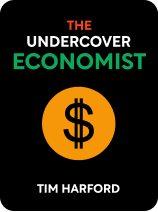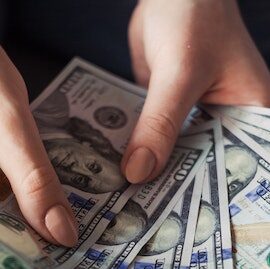

This article is an excerpt from the Shortform book guide to "The Undercover Economist" by Tim Harford. Shortform has the world's best summaries and analyses of books you should be reading.
Like this article? Sign up for a free trial here .
Why do brands charge different prices for different customers for nearly identical products/services? Is the higher-priced product really significantly better than its lower-tier option?
It’s no secret that companies can charge different prices for different customers. Once you realize that sellers base their prices in part on what they think you’re willing to pay, you can make better decisions about what you buy, where you buy it, and how much to spend on it.
In this article, we’ll explore how companies can charge different prices to different customers, and what it means for you as a buyer.
Multiple Price-Points
While individuals and companies can look to profit from scarcity, they don’t have ultimate power over their consumers. No matter how scarce their resource are, if a company sets its price too high, the customer won’t buy what they’re selling. What they can do, though, is employ the strategy of price targeting, or setting different prices for different customers.
A typical Starbucks menu illustrates how companies can set unique price points: They have regular coffees, cappuccinos, or hot chocolates priced at a fairly low rate—let’s say $2. But if you want a larger size, or a special bean, or even a blend of two different types of coffee, you pay more—maybe $3. Customers know it doesn’t cost Starbucks an extra dollar to manufacture these “fancier” items, but some customers are still willing to buy them. The customer who just wants her coffee and is money-conscious might go for the $2 coffee. But the customer who cares less about what her coffee costs and is curious about a particular blend will go with the more expensive option. Businesses are constantly looking for the latter customer or the one who doesn’t care as much about the price.
One way for companies to find customers that care less about the price is to rent storefronts in prime locations. For example, storefronts for coffee shops in train stations are desirable. Customers getting a coffee on the way to catch a train are likely to be less discerning about the price, given that they have a train to catch and don’t have time to leave the station and look for a lower-priced option.
However, even storefronts in prime locations need to practice price targeting. If the coffee shops in train stations sell their coffee at too high a markup, even though they’re the only coffee shop in the area, people will just forgo their coffee. But if they sell coffee at too low of a price, they won’t make enough money to turn a good profit, because their rent is so high due to the desirable location. This is why setting different price points, so that people who are willing to pay more will, and people who aren’t won’t (but will still buy something), works so well.
Finding Good Customers
There are three ways that businesses go about finding desirable customers:
1. The first strategy is to think of every customer as a “unique target.” The sellers in this scenario attempt to sell each of their products at the highest price that each customer is willing to pay. However, it requires a lot of time, energy, and skill as a salesperson to ascertain exactly what each customer is willing to pay. This wouldn’t work for a coffee shop, for example. Generally, it’s salespeople renting homes or selling used cars who will employ this strategy. The items sold have to have enough value that it’s worth the time of the salesperson to figure out their customer’s price. While this strategy is time-consuming, it’s also theoretically how salespeople can make the most money, because they’re charging each one of their customers exactly how much that customer is willing to pay.
Because it can be so profitable, companies have started attempting to automate this process. Some supermarkets, for example, will give you “loyalty” or “discount” cards, which lets them track what you are purchasing (and thereby what you are willing to buy). It’s not a perfect system, because the data only lets them provide individual customers with coupons to lower the price of some goods, but it’s still an attempt to understand each customer’s individual preferences. In the past, large internet companies like Amazon have experimented with charging some customers more money for the same product than others based on their purchasing history, but when customers found this out, they were angry, and Amazon had to stop the practice.
2. The next strategy is to split customers into groups and charge each group different prices. While people were angry at Amazon for charging different prices based on individual purchasing tendencies, they don’t tend to get upset about group discounts or price hikes. Think about how museums will charge less money for students and the elderly, who likely have less disposable income, and the grand majority of people find this fair.
We should remember, though, that companies doing the group strategy are not truly concerned with what their customers can afford. Rather, they’re concerned with what customers are willing to pay. At Disney World, they have a 50 percent discount for locals. This isn’t because everyone who lives near Disney World is poor, but because they’re less willing to pay full freight given that they live in the area and are not on vacation, a time when many people are more careless about money. The people who live near Disney World might come four times a year if Disney World reduces prices, while vacationers will almost certainly go only once a year at most, no matter the price. Essentially, what every business should ask themselves is how much less are we selling when we raise the price, and how much more are we selling when we lower the price? We’ll call this question price sensitivity.
3. The final strategy is to let customers tell you how much they’re willing to spend on a good or service. This is called price targeting. This is what coffee shops like Starbucks do: By offering goods that are just slightly different from one another, they’re basically asking customers how much they would like to pay for their coffee. Obviously, this is a simplification. When two products are similar (but not the same), it’s difficult to know whether a company is trying to price target or whether one product is simply more expensive for the company to produce. However, companies are attempting to make as much money as they can, so it’s probably more likely that if two products are similar but one costs a decent amount more than another, the company is price targeting.
This doesn’t just happen with similar products. As we described in the introduction to this section, where a store is located will likely change how they price their goods as well. For example, if they’re closer to a major transportation hub, products will be more expensive. Customers could always walk to a less expensive place a ways away, but it’s not worth the walk for enough customers that these places continue to make money.
Generally, successful businesses also do some virtue signaling. Think back to the example of charging children and the elderly less for admission to a museum. It’s hard to object to a decision like this, as it looks like a public good. The most widespread example of this in recent years has been the proliferation of organic or fair trade goods. People who are less concerned about how much money they’re spending on their groceries are generally much more willing to buy goods labeled organic or fair trade because they believe these products to be better for themselves and for the world. They are likely correct. But these products are also marked up a lot, and supermarkets make a lot of money off of the markups. Rarely will stores put the organic and non-organic versions of the same product right next to each other, because customers would be too shocked by the price disparity.
What Does “Expensive” Mean?
People think Whole Foods is an expensive grocery store. But compare the prices of regular onions at a Whole Foods to the prices of regular onions at an “inexpensive” grocery store like Safeway. They’re the same. The reason that most customers think Whole Foods is so expensive is that when they’re there, they’re buying expensive goods. A sense of what is “luxurious” is different between Whole Foods and Safeway. Whole Foods stocks more expensive goods, so the scale shifts. While buying seltzer at Safeway might be luxurious, at Whole Foods, it looks more like a basic because of all the more expensive goods around. While the price of regular onions at the two stores is the same, Whole Foods has the option of many more varieties of more expensive onions. Bargains don’t come from “inexpensive stores” but from buying inexpensive goods.
Companies’ Power
As we’ve demonstrated, power in the market comes from scarcity. However, businesses often achieve greater scarcity more from consumers’ laziness than from any unique place they have in the market. Coffee shops or grocery stores next to train stations can charge huge markups not because they’re the only business of their kind in a two-mile radius, but because they’re the only business of their kind in a quarter-mile radius, and people are too lazy or in too much of a rush to search further afield.
These businesses will often even charge wildly different prices within their stores, sometimes marking up a vegetable, for example, by a factor of three every few weeks. The people who notice likely won’t buy that particular vegetable the week it’s much more expensive, but a lot of people simply aren’t paying close attention.
While it seems like companies have great power over consumers, there are two major ways where this can go wrong for companies. Here are the potential problems and how companies solve them:
1. When customers don’t self-target. It can sometimes be difficult to get customers not to buy the cheaper goods. While it’s true that many customers are lazy, they also have eyes, and so they might turn away from something that they deem to be overpriced. This was especially a problem with travel–everyone on the same airplane or train is going from point A to point B, so it often makes little sense to buy more expensive tickets.
To solve the problem of people being unwilling to buy first class tickets, train and airplane companies decided they had to make the least expensive options so unappealing that rich people would decide they wanted to spend the extra money. The “value” aisle at supermarkets, which is often meant to look shoddy, serves the same purpose. IBM once made two printers, a “value” version and an expensive version. The printers were the same, except that IBM inserted a chip into the value printer to slow it down. The best way for many companies to price-target is to make the cheap options untenable. They sabotage some of their business to convince wealthier customers to buy the non-sabotaged version.
2. When discount customers resell their products. Not all products can be resold. Supermarkets and airlines don’t have this issue, so they can more easily price gouge. The DVD industry, though, does have this problem. In an attempt to mark up their services in Europe, the industry made sure that DVDs bought in the States wouldn’t function properly in Europe. However, various other competitors have popped up who have agreed to rig up DVD machines in Europe to read DVDs from the U.S. In industries that are more susceptible to resale, there’s a constant push and pull between companies attempting to price target and customers attempting to get around these efforts.
When Price Targeting Is Good
So far in this section, it’s likely seemed like companies are constantly looking for ways to scam customers to make more money themselves. Think about the pharmaceutical industry. Pharma companies put huge amounts of money into the research and development of new drugs only because they know that if these drugs work, they’ll be able to sell them at huge markups. Often, a drug that costs $10 to produce can sell for $1000 in much of the world, especially if it’s a life-altering treatment. However, in some places in the world, people can’t afford to spend $1000, even if they really need the treatment. So pharma companies might sell their pills to poorer people for $50 instead of $1000. If pharma companies knew that they could only sell their goods for $50 around the world, it wouldn’t be worth it for them to put so much effort and money into the development of new drugs. But knowing that they can price target allows them to create life-saving treatments.
When Price Targeting Is Bad
Just like price targeting can lead to a public good, it can also lead to bad outcomes. Lots of train and airplane companies will sell a few seats for a big discount (maybe at $50) and the rest for $100. In this situation, some people who need to get on that flight can’t, because they didn’t manage to secure a discounted ticket, can’t pay $100, but would have been willing to pay $90. Some of the people who did get a discounted ticket, by contrast, would have only been willing to pay $60 for their seat and aren’t in such a rush to get to their destination. What ends up happening is people who need the seat less (and are willing to pay less) end up with the seat. In this case, it would have been better to just set one price.
Basically, we can consider the two scenarios, and price targeting in general, like this: If price targeting creates new markets without affecting old ones, it’s good. If it doesn’t expand old markets and rather allows people who value products less to acquire them, it is worse than having a uniform price. A lot of price targeting ends up falling somewhere in between the two scenarios—it opens up some new markets but also creates inefficiencies and puts people off of the old markets.

———End of Preview———
Like what you just read? Read the rest of the world's best book summary and analysis of Tim Harford's "The Undercover Economist" at Shortform .
Here's what you'll find in our full The Undercover Economist summary :
- How to think like an economist
- How to use principles like scarcity, price targeting, the stock market, and game theory to make better decisions every day
- Why the economy is mostly about people, not complex math, graphs, or jargon






